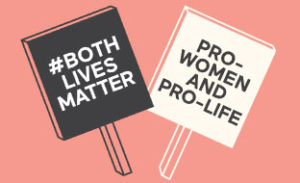In response to “Bex’s story – I am a pro-life feminist” a conversation was begun. So we asked that friend, who’s not exactly “with us” but not “against us” either, for her view on the subject of abortion and where, for the women facing pregnancy crisis, we need to find “common ground”.……..
“To call the current pro-life/pro-choice discourse a “debate” is the understatement of the century. The conversation regarding abortion has created nothing short of a canyon between the two sides.
Exasperated with this canyon that the pro-life/pro-choice debate has become, I’d like to point out the harm that this polarization has caused to any meaningful headway on the issue towards both sides’ goals. Therefore, the conversation needs to shift, ideally towards concrete, viable solutions to this complex issue. I propose a bridge to span the current canyon, which I refer to as “abortion-reduction”.
Whether advocating for the legalization or criminalization of abortion, both sides of the mainstream pro-choice/pro-life divide have consistently been guilty of insisting on the complexity and truth in their theory, while simultaneously carving out the “other side” as overly simple and wholly incorrect in their reasoning.
Each are standing on opposite sides, divided by a vast canyon, as they yell at the other with picket-signs. One side shouts at the other, “We’re right because…”, while the other screams, “No, we’re right because…”. As they dig their feet into the edges of their cliffs, eyes fixed with hatred on their opponent across the canyon, they fail to gaze down below. There, in the depths of that canyon, real women and real babies tread below, getting lost in the whirlpool current of economic structures and social institutions that threaten them.
Beyond this single-minded ideological jargon, there exists a basic, concrete aim in each perspective. Pro-lifers seek, fundamentally, the well-being of those in wombs. Pro-choices seek, fundamentally, the well-being of those with wombs. A mere preposition is what separates the two. However, if each side insists on digging their heels into their place and rejecting meaningful discourse, the well-being of both un-born children and women will continue to suffer. In other words, the debate has become so focused on “the world as it should be”, that the debaters have forgotten “the world as it is”.
Abortion-reduction attempts to acknowledge the ideological differences between these two, while pushing towards a mediated discourse that puts the actual realities surrounding those in and with wombs into the foreground. It rappels into the canyon and seeks to build a bridge between both sides. It says, let us start in reality, seeking to diminish the number of abortions by getting to the root causes that lead to them.
The mediation can only happen when we all take a step back from the traditional question: Why is abortion “good” or “bad”? Instead, we must focus on asking: Why are women having abortions?
This is a semi-rhetorical question. Because, here, specific answers are not the key. Rather than searching for one ‘right’ answer, this question is meant to move the debate away from its impasse, and towards the deeper social, economic, psychological and physical causes behind abortion.
I won’t lay out one answer to this question. Instead I will ask both pro-life and pro-choice advocates to hold back their typical, knee-jerk responses and instead reconsider the realities that lead to abortions. Rather than laying out specifics, I’ll begin this alternate conversation with the fact that a myriad of complex, socio-economic factors increase the likelihood of the occurrence of an abortion. Therefore, in order to care for both those with AND in the womb, we need to focus efforts on alleviating the environments and factors that prompt abortion.
Moving away from the pro-choice/pro-life dichotomy, the bridge of abortion-reduction puts forth a different set of “pro-’s”. These are focused on tactics aimed at preventing unplanned pregnancies, while also restoring and supporting those in and with wombs.
These “pro-’s” of abortion-reduction include:
Preventative
- Pro-sexual-education (safe practices and healthy relationships)
- Pro-safe-and-available-contraception (directly reducing unplanned pregnancies)
- Pro-economic-support (reducing financial obstacles to education and contraception for populations most at-risk for unplanned pregnancies)
Restorative/Supportive
- Pro-those-from-wombs (supporting those already born, including improving foster-care and adoption practices)
- Pro-those-with-wombs (their health all throughout and long after pregnancy)
- Pro-continued-economic-support (cultivating the next generation in educational opportunities and safety)
This list is neither exhaustive, nor is it static. It is the beginning of the mediation process between the two sides of the current debate. It attempts to re-frame the conceptual deadlock into tangible solutions for the here and now.
Both sides of this deadlock have long focused their attention on legality and morality. Instead, we must see that tangible solutions will be found in sociology and economics. The conversation must move from legislatures and churches, into schools and hospitals. If there is any progress to be made, that is, if both sides actually want what is best for those in and with wombs, then each side needs to reconsider their own rhetoric and ultimate goals. If they do truly want to foster life or protect choice, the canyon must be crossed. Abortion-reduction can be a step towards transforming the current political impasse into a meaningful discourse with practical solutions.”
Both Lives Matter stands with women and children, and in doing so, we will continue to defend the law in Northern Ireland which protects the life, health and dignity of them both. But we know that it’s not enough for us to say “no” to abortion; we must understand why women turn to abortion and then address the external circumstances that are causing the pregnancy crisis and in so doing enable both lives. We want to engage with those who may not agree with us on everything, and then we hope that we can work together towards supporting every woman and every unborn child in every pregnancy.

